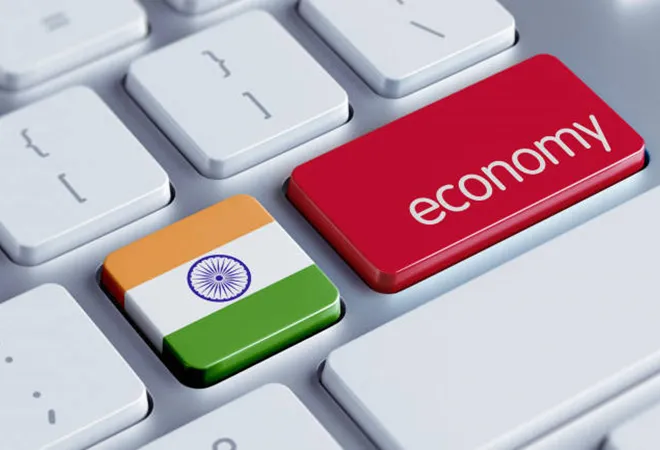-
CENTRES
Progammes & Centres
Location

The 7.7% growth in India’s gross domestic product (GDP) in the fourth quarter of financial year 2018 is more than a numerical statistic cobbled together by Prime Minister Narendra Modi’s policies, less than the record 10%-plus benchmark set by former Prime Minister Manmohan Singh government during 2010, and way below what India’s potential can be. Already the world’s fastest-growing large economy, this number strengthens India’s growth trajectory and gives us the luxury to think beyond, to aspire for a sustainable double-digit growth, which is not merely the announcement of the country’s coming of age but a necessity to carry millions of Indians on this growth train and offload them on a platform called Middle Class.
It is more than a statistic in the usual sense of the word because it captures within it the two strongest headwinds that India businesses have faced in the past two years, and arguably since 1991 — demonetisation and GST. Demonetisation that ruptured the informal economy, hurt cash sensitive sectors such as real estate, and reportedly led to job losses. And the biggest structural reform India has witnessed in the form of the introduction of the goods and services tax that began with sputters of administrative excesses but has now calmed down to a predictable and stable process.
"The short-term pain notwithstanding, for the economy to negotiate these headwinds sector after sector, one enterprise at a time, shows the resilience of India’s business community in general and the grit of India’s entrepreneurs in particular. Give them a problem and they will find a way."
Headwinds of policy are not new to Indian business. From the intense bureaucracy, strong Inspector Raj and excessive controls of the 1960s and 1970s have already become the new normal. Entrepreneurs have found their way around these hurdles, while successive governments have flushed this policy sewage out. But what has not changed is an overall sense of suspicion against Indian businesses that exists till today. It is unlikely that the business community in any significant country would have faced such resistance to doing business, to building enterprises, to delivering jobs on the way and creating wealth as a sweet outcome than India. This is a national tragedy that the policy space ignores but desperately needs to rectify. We want to feed off the taxes of our enterprises but not respect the entrepreneurs behind them.
While there is no data to back it, part of this quarter’s GDP growth is due to the formalisation of the economy, brought about by the demonetisation-GST duo — the former by the entry of money into the formal banking sector through the doors of KYC (know your customer), the latter through a smart process of tax credits, both riding the fast train of digitalisation that India has embraced at a never-seen-before speed. Now that demonetisation has done what it needed to and waits for big data to segregate unaccounted-for money in the system form legitimate wealth, the GST system has more or less stabilised and businesses have adjusted to yet another new normal that has replaced 17 taxes with a single one, these headwinds will turn into tailwinds, tax stability will now translate into business stability and, ceteris paribus, push the economy towards a virtuous cycle of growth.
That said, 6.7% growth for the full year is only a start. It is unsatisfactory for an economy of India’s stage of development. Economically, this statistic it is an opportunity to consolidate the gains, visible and invisible, from policies that seem unrelated but in fact are part of a larger whole. Politically, it lags the growth rates delivered by Manmohan Singh’s government — this government needs to deliver more. But with the treasury filling up on both the indirect and direct taxes side, growth in taxes exceeds the growth in the economy and gives Modi a strong base with which to deliver social policies, crucial in his last nine months of his tenure as Prime Minister. The next three months should see the rollout of what may become this government’s flagship scheme — the National Health Protection Mission (NHPM) — a scheme as important to Modi as the MGNREGA was to Manmohan Singh.
"In the journey of nations to prosperity, one statistic over one quarter is insignificant. The polarised politics of today doesn’t allow the government to indulge in a full-blown celebration of growth."
And, except in relative terms it doesn’t permit the Opposition to dismiss the number either. We need to see this number only as a start. We also need to get real: in a world that is increasingly transacting with ferocious tools of trade tariffs and economic sanctions, maintaining this growth in the short term will be a challenge. It would also be a time to get our house in order, remove the hurdles before our entrepreneurs and catalyse them towards attaining global scale. Unfortunately — and sadly so — we will have to wait for the results of Elections 2019 and see how the next government brings these changes.
Until then, expect GDP growth to rise at a higher rate over the next two quarters, tax revenues to gallop faster, leading to an increase in the tax-GDP ratio, which could cross 18%. But keep two risks in mind: global trade wars and rising oil prices.
The views expressed above belong to the author(s). ORF research and analyses now available on Telegram! Click here to access our curated content — blogs, longforms and interviews.

Gautam Chikermane is Vice President at Observer Research Foundation, New Delhi. His areas of research are grand strategy, economics, and foreign policy. He speaks to ...
Read More +